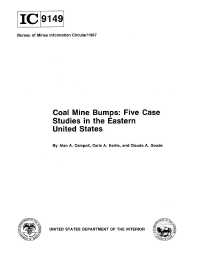Mining Publication: Coal Mine Bumps: Five Case Studies in the Eastern United States
Original creation date: January 1987
This Bureau of Mines study was conducted to obtain a better understanding of the coal mine bump problem and its effect on underground coal mining in the eastern United States. To accomplish this, information was collected on the geologic conditions, mining techniques, and engineering parameters at five bump-prone mines. Two geologic conditions have been found to cause the occurrence of bumps in the eastern United States: (1) relatively thick overburden and (2) extremely rigid strata occurring immediately above and below the mine coalbed. Additionally, the probability of bump occurrence is increased by certain mining practices that concentrate stresses during retreat mining in areas where geologic conditions are conducive to bumps. Mining plans that permit the development of pillar line points or long roof spans that project over gob areas should be avoided because these features may contribute to the occurrence of bumps.
Authors: AA Campoli, CA Kertis, CA Goode
Information Circular - January 1987
NIOSHTIC2 Number: 10006080
Pittsburgh, PA: U.S. Department of the Interior, Bureau of Mines, NTIS PB90-265505, IC 9149, 1987 Jan; :1-34
See Also
- Deep Cover Pillar Recovery in the US
- Design Methods to Control Violent Pillar Failures in Room-and-Pillar Mines
- Pillar Design Issues for Underground Stone Mines
- Proceedings: New Technology for Ground Control in Retreat Mining
- Rock Mechanics Investigations at the Lucky Friday Mine (In Three Parts): 1. Instrumentation of an Experimental Underhand Longwall Stope
- Roof Span Design for Underground Stone Mines
- The State-of-the-Art in Coal Pillar Design
- Technology News 516 - ARMPS-HWM: New Software for Sizing Pillars for Highwall Mining
- Toward Pillar Design To Prevent Collapse of Room-and-Pillar Mines
- Using the Coal Mine Roof Rating (CMRR) to Assess Roof Stability in U.S. Coal Mines
- Content source: National Institute for Occupational Safety and Health, Mining Program


 ShareCompartir
ShareCompartir
